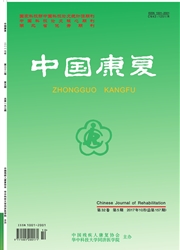

 中文摘要:
中文摘要:
目的:探讨电针对脑缺血大鼠海马神经元凋亡的作用及可能内在机制。方法:将90只雄性SD大鼠随机分为假手术组、模型组、电针组、电针+PKA抑制剂(H89)组和电针+生理盐水(Ns)组,每组又分为7d、14d、21d3个亚组。制备双侧颈总动脉永久性结扎(2VO)模型;电针百会穴(GV20)和大椎穴(GV14);通过TUNEL法和免疫蛋白印迹法观测海马神经元凋亡及Bax蛋白、Bcl-2蛋白表达量。结果:各组大鼠组内3个时间点间的海马神经元凋亡率相比,模型组14d组、21d组较7d组显著增加(P〈O.05);其余各组各时间点差异均无统计学意义。凋亡相关蛋白表达量比较,电针组21d组较14d组Bcl-2蛋白量显著增多(P〈0.05)。其余各组各个评价指标在3个时间点比较差异无统计学意义。同时间点各组大鼠间海马神经元凋亡率比较,模型组较假手术组均显著增加(P〈0.05);电针组较模型组均显著降低(P〈0.05);电针+H89组较电针+NS组均显著增多(P〈0.05)。同时间点各组大鼠间的凋亡相关蛋白表达量比较,模型组较假手术组Bax蛋白量均显著增高(P〈0.05),而Bcl-2蛋白量均显著降低(P〈0.05);电针组较模型组Bax蛋白量均显著降低(P〈o.05),而Bcl-2蛋白量均显著增加(P〈0.05);电针+H89组较电针q-NS组Bax蛋白量均明显增多(P〈0.05),而Bcl-2蛋白量明显降低(P〈0.05),但在14d时2组Bcl-2蛋白表达差异无显著统计学意义。结论:电针百会穴和大椎穴可抑制Bax蛋白表达,促进Bcl-2蛋白表达而减轻脑缺血大鼠海马神经元凋亡,给予H89后电针的作用被抑制,说明电针抗凋亡作用的内在机制可能与激活PKA-CREB信号通路相关。
 英文摘要:
英文摘要:
Objective: To investigate whether electroacupuncture (EA) protects hippocampal neurons from apopto- sis and its probable mechanism in rats following cerebral hypoperfusion. Methods: Ninety male Sprague-Dawley (819) rats were randomly divided into five groups: a sham-operated control group (Con), a model group (Mod), an EA group (EA), an EA combined with intracerebroventricular (ICV) injection of PKA blocker H89 group (EA+ H89) and an EA combined with ICV injection of normal saline (NS) group (EA+NS). Each group included three time courses: 7 days, 14 days and 21 days. Cerebral hypoperfusion was induced by permanent and bilateral common carotid artery occlusion (2-vessel occlusion, 2VO). EA was given on GV20 and GV14. TUNEL and Western blot- ting were employed to observe apoptosis of neurons and expression changes of Bax and Bcl-2 proteins of the hippo- campus. Results: In the Mod group, the apoptosis rate was significantly higher on day 14 and 21 than on day 7 (P〈0.05), and there was no significant difference in other groups among the three time points. In the EA group, the expression of Bcl-2 protein was significantly higher in the 21-day subgroup than in the 14-day subgroup (P〈0. 05), and there were no significant differences in other groups. Percentages of apoptotic neurons were higher in the Modgroup than in the Con group (P~0. 05), but lower in the EA group than in the Mod group (P〈0. 05). In the EA+H89 group, protecting effects of EA were weakened, and those in the EA+NS group had no sig- nificant change. Western blotting suggested that the expression of Bax protein was signi{icantly up-regulated (P〈0. 05) and that of Bcl-2 protein significantly down-regulated (P〈0. 05) in the Mod group as compared with the Con groups, and the Bax protein significantly reduced (P〈0. 05) and the Bcl-2 protein significantly increased (P〈0. 05) in the EA group as compared with the Mod group. In the EAq-H89 group, the Bax pro
 同期刊论文项目
同期刊论文项目
 同项目期刊论文
同项目期刊论文
 期刊信息
期刊信息
